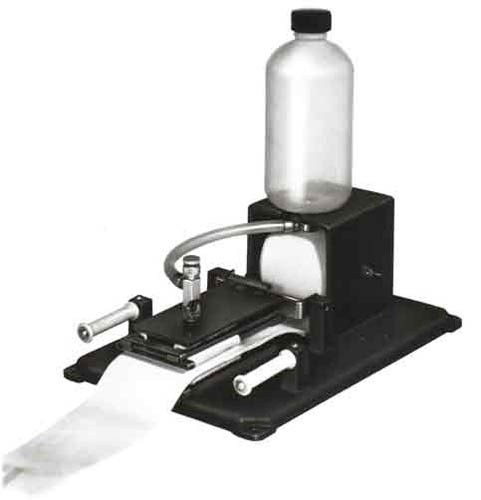|
Author
|
Topic: Film Cleaning Can Damage Film
|
|
|
|
|
Hugh Thompson Scott
Film God
Posts: 3063
From: Gt. Clifton,Cumbria,England
Registered: Jan 2012
|
 posted May 16, 2013 11:44 AM
posted May 16, 2013 11:44 AM



Hi Laksmi,well I have been handling film now for nearly 45 years
and have never experienced any damage by appling a lubricant
to the film proper.I used to use a soft cloth at first but soon
changed to chamois leather, as this doesn't leave fluff.The green
marks I would suspect have been acquired from the projector
used, as I have not experienced serious scratches of this nature from applying
a liquid cleaner/lubricant. Even Derek Simmonds advocated the
purchaser of a film to give it a treatment before projection,as this eradicated the "green print" judder and helped prevent
scratching, and Derek as you know,cut his teeth as an "old school" film projectionist.No I feel it safe to say that as long as
you follow the instructions applying the liquid,and change the
surface you're applying it with,there should be no problems.
If the print is very dirty,then I have found that passing it between two clean paint brushes will take off any surface muck
before application of a cleaner.The main cause of any film damage is down to the machine.Back in the early '70's, some
film libraries were seriously considering not hiring out s/8 prints
on account of the new films coming back ruined, the same did not apply to standard 8mm.The odds on film scratches are
increased everytime a film is projected.
| IP: Logged
|
|
|
|
Paul Adsett
Film God
Posts: 5003
From: USA
Registered: Jun 2003
|
 posted May 16, 2013 12:47 PM
posted May 16, 2013 12:47 PM



I think we should not forget the other reason to clean your films periodically, and that is the need to lubricate and prevent shrinkage. I do not use commercial film cleaners because I am concerned about health issues from volatiles. That's just me. So I use Armorall wipes which I have found do a pretty good job of cleaning and masking light scratches. And these wipes also lubricate and recondition the film base to help eliminate shrinkage and embrittlement. I have used Armorall on the dash of my '93 Honda Accord for the past 20 years, and the dash is just like new, which is really saying something in the Florida heat and sunshine. So I figure what is good for my car dash is also good for my films, and so far (15 years) it has worked out very well for me with no adverse effects - just clean, smoother running, prints.
--------------------
The best of all worlds- 8mm, super 8mm, 9.5mm, and HD Digital Projection,
Elmo GS1200 f1.0 2-blade
Eumig S938 Stereo f1.0 Ektar
Panasonic PT-AE4000U digital pj
| IP: Logged
|
|
|
|
|
|
|
|
|
|
|
|
Roy Neil
Expert Film Handler
Posts: 203
From: Menlo Park, CA
Registered: Sep 2007
|
 posted May 16, 2013 02:17 PM
posted May 16, 2013 02:17 PM




While I agree with the topic of this thread I can not say I heartily agree with the substance of your message Laksmi.
I manufacture a film cleaning system called "Film-O-Clean" - which is designed to be used constantly - meaning it is completely safe to use each time a film is projected.
Cleaning the film as it is projected:
- Lubricates the print and prevents excessive wear which leads to scratches
- Cleans the print which prevents not only hairs in the gate, but also works to prevent the accumulation of debris within the projector ( especially the gate )
- The film is cleaner than the last time you watched it, automatically. Unless of course it has no debris at all in which case it works to keep it in that pristine condition.
- Wet gate projection will hide base scratches by removing the debris from the scratch, then, leaving the void filled with a miniscule amount of fluid ( FilmGuard primarily )
- The cleaning media is constantly advancing, automatically, so fresh media is always in contact with the film. Likewise, dirt from the head will never touch the tail - unlike cleaning with a " t-shirt " or " webril "
- The cleaning media is manufactured by FilmTech is is soft enough to clean lenses without harming the lens coating.
Film-O-Clean has been tested by not only myself, but also Wittner-Cinetec - and our own Doug Meltzer provided a wonderful review here on this forum
Doug Meltzer's Film-O-Clean Review
Likewise there are others
http://8mmforum.film-tech.com/cgi-bin/ubb/ultimatebb.cgi?ubb=get_topic;f=5;t=000622
http://8mmforum.film-tech.com/cgi-bin/ubb/ultimatebb.cgi?ubb=get_topic;f=1;t=006228
http://8mmforum.film-tech.com/cgi-bin/ubb/ultimatebb.cgi?ubb=get_topic;f=1;t=007250
Here is one of several videos on YouTube
http://www.youtube.com/watch?v=OavNILdp3IU
Film-O-Clean is more than three years old - with not a single complaint nor request for refund/return.
Wittner-Cinetec performed independent testing of Film-O-Clean and verified that not only will it not damage film but that it is the best method for cleaning film bar none.
So .. while I agree that cleaning film improperly can and will damage film - I do not agree that cleaning film is detrimental to the film, I would state the opposite - that not cleaning film is a fantastic way to:
- Damage film while projecting
- Spread dirt from print to print
- Cause excess wear to the projector ( especially gate )
- Cause debris to accumulate within the projector
- and likely more pitfalls I am not considering at the moment
Granted, as a manufacturer - I am bound to be biased toward my own product - so I will ask and encourage others who have used Film-O-Clean to please share your own information and experiences. I feel this is important lest false or misleading information make its way into the books as 'fact'
| IP: Logged
|
|
|
|
|
|
Bill Brandenstein
Phenomenal Film Handler
Posts: 1632
From: California
Registered: Aug 2007
|
 posted May 16, 2013 06:23 PM
posted May 16, 2013 06:23 PM



I wish a Film-O-Clean were in my budget.
I concur. Improper cleaning and handling can damage film, without a doubt. However, I've never damaged a film unless significant excess pressure was used, in combination with a situation where lubrication was needed. And it was really, really tough to do.
Laksmi, I really don't think the green scratch will happen from a cloth very easily because the particles will take the path of least resistance - which is into the fibers of the cloth. Very different from the unforgiving metal parts of a film gate. A green scratch from a cloth means WAY too much pressure and no lubrication.
It's not too hard, with a loupe under a bright light, to see minor surface abrasions.
Scariest thing I ever did was to "clear" a never-run polyester film (which scratches more easily than acetate) that had been treated years ago with Surfaset - leaving a thick waxy residue - by wiping it down with cotton cloth to make it "transparent" again. It took a crazy amount of pressure and passes to buff it down. Yet, no scratches, film is gorgeous, lubrication will last for many years. (The long lab leaders were VERY helpful for testing!)
| IP: Logged
|
|
|
|
|
|
|
|
|
|
Hugh Thompson Scott
Film God
Posts: 3063
From: Gt. Clifton,Cumbria,England
Registered: Jan 2012
|
 posted May 17, 2013 03:06 AM
posted May 17, 2013 03:06 AM



I completely agree with Adrian Laksmi,if you've been suffering
any scratches on your films, and by the sound of it,these green
and blue marks are serious defects.I don't think that damage as serious as that could be done by wiping with a wet rag,anyway
the scratch would "weave" and not be in one place consistantly.
A simple test,and one we can all do periodically,is to make a loop
of coloured waste film and run it for an hour or so in the projector
then examine for marks.I say again,that Elmo, with the plastic guides will eventually wear with use and mark film,a sad fact
but true, and yours will be no exception Laksmi.It's been done
to death on this forum,but the plastic by its nature will wear
and then the fun starts.I did send you print offs from mags
that identified the parts that cause the "aggro",but alas they
can't be replaced now.
| IP: Logged
|
|
|
|
|
|
|
|
|
|
|
|
|
|
|



 UBBFriend: Email this page to someone!
UBBFriend: Email this page to someone!
 Printer-friendly view of this topic
Printer-friendly view of this topic










![[Roll Eyes]](rolleyes.gif)
![[Cool]](cool.gif) bolted on the front of the projector. The thing is, friction causes wear on the film in the gate and on sound head etc. What Roy has made, takes "care" of your films for many years to come....
bolted on the front of the projector. The thing is, friction causes wear on the film in the gate and on sound head etc. What Roy has made, takes "care" of your films for many years to come.... ![[Smile]](smile.gif) ...with some "Thermofilm" when you could get it...and thats it. I never used the projector for rewinding films either, it was always done by hand.
...with some "Thermofilm" when you could get it...and thats it. I never used the projector for rewinding films either, it was always done by hand.



